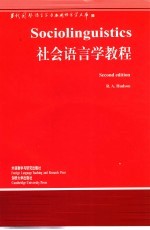

社会语言学教程PDF电子书下载
- 电子书积分:11 积分如何计算积分?
- 作 者:R.A.Hudson著;杜学增导读
- 出 版 社:北京:外语教学与研究出版社
- 出版年份:2000
- ISBN:7560020070
- 页数:284 页
1 Introduction 1
1.1 Sociolinguistics 1
1.1.1 A description 1
1.1.2 Sociolinguistics and linguistics 2
1.1.3 Sociolinguistics and the sociology of language 4
1.2.1 An imaginary world 5
1.2 Sociolinguistic phenomena 5
1.2.2 A real but exotic world 6
Preface by Halliday 9
1.2.3 A real and familiar world 9
1.3 Speakers and communities 10
1.3.1 Conformity and individualism 10
王宗炎序 10
导读 13
1.3.2 The sociolinguistic development of the child 14
1.4 Summary and conclusions 17
2 Varieties of language 20
2.1 Introduction 20
2.1.1 Global and specific statements 20
2.1.2 Linguistic items 21
Preface to the second edition 22
2.1.3 Varieties of language 22
2.1.4 ‘Speech communities’ 24
Preface to the first edition 24
2.2 Languages 30
2.2.1 ‘Language’and ‘dialect’ 30
2.2.2 Standard languages 32
2.2.3 The delimitation of languages 34
2.2.4 The family tree model 37
2.3 Dialects 38
2.3.1 Regional dialects and isoglosses 38
2.3.2 Diffusion and the wave theory 39
2.3.3 Social dialects 41
2.3.4 Types of linguistic item 43
2.4 Registers 45
2.4.1 Registers and dialects 45
2.4.2 Diglossia 49
2.5 Mixture of varieties 51
2.5.1 Code-switching 51
2.5.2 Code-mixing 53
2.5.3 Borrowing 55
2.5.4 Pidgins 59
2.5.5 Crevles 63
2.6 Conclusions 68
3 Language,culture and thought 70
3.1 Introduction 70
3.1.1 Culture 71
3.1.2 Thought 72
3.1.3 Language,culture and thought 78
3.2 Linguistic and cultural relativity 81
3.2.1 Semantic relativity 81
3.2.2 Prototypes 85
3.2.3 Basic-level concepts 88
3.2.4 Conclusions 90
3.3 Language and thought 91
3.3.1 Language and socialisation 91
3.3.2 The Sapir-Whorfhypothesis 95
3.3.3 Sexism in the language system 102
3.4 General conclusions 104
4 Speech as social interaction 106
4.1 The social nature of speech 106
4.1.1 Introduction 106
4.1.2 The classification of speech 109
4.1.3 Speech as skilled work 112
4.1.4 The norms governing speech 116
4.1.5 Conclusion 119
4.2 Speech as a signal of social identity 120
4.2.1 Non-relational social categories 120
4.2.2 Power and solidarity 122
4.2.3 Linguistic signals of power and solidarity 127
4.3 The structure of speech 132
4.3.1 Entries and exits 132
4.3.2 Other kinds of structure in speech 134
4.4 Verbal and non-verbal behaviour 136
4.4.1 Relation-markers 136
4.4.2 Structure-markers 138
4.4.3 Content-markers 139
4.5 Male/female differences in speech 140
5.1 Introduction 144
5.1.1 The scope of quantitative studies of speech 144
5 The quantitative study of speech 144
5.1.2 Why study speech quantitatively? 148
5.2 Methodology 150
5.2.1 Problems of methodology 150
5.2.2 An example:New York 155
5.2.3 An example:Novwich 159
5.2.4 An example:Belfast 163
5.2.5 An example:Cardiff 164
5.2.6 An example:Detroit 166
5.3 Linguistic variables 169
5.3.1 Types of variable 169
5.3.2 Calculating scores for texts 175
5.3.3 Calculating scores for individuals and groups 177
5.4 Influences on linguistic variables 181
5.4.1 Linguistic context 181
5.4.2 The speaker s group membership 184
5.4.3 The speaker s degree of group membership 190
5.4.4 The speaker s sex 193
5.4.5 The situation and style 199
5.5 Summary 201
6 Linguistic and social inequality 203
6.1 Linguistic inequality 203
6.1.1 Introduction 203
6.1.2 Three types of linguistic inequality 205
6.2 Subjective inequality 206
6.2.1 Language-based prejudice 206
6.2.2 Evaluation of language 209
6.2.3 Stereotypes and how to study them 211
6.2.4 Prejudice of teachers 216
6.2.5 Prejudice of pupils 217
6.3 Linguistic incompetence:strictly linguistic inequality 220
6.4 Communicative incompetence:inequality in communication 224
7.1 Introduction 228
7 Theoretical summary 228
7.2 The social functions of language 230
7.2.1 Face 230
7.2.2 Solidarity and accommodation 232
7.2.3 Networks and multiple models 234
7.2.4 Social types and acts of identity 237
7.2.5 Power 240
7.2.6 Analogue relationships and variability 241
7.3.1 Background 243
7.3 The structure of language 243
7.3.2 The history of the isolation of language 244
7.3.3 Evidence against the isolation of language 245
7.3.4 Two further sources of variability 248
7.3.5 Implications for theories of language structure 252
Bibliography 258
Index 271
文库索引 280
- 《红色旅游的社会效应研究》吴春焕著 2019
- 《高级英语阅读与听说教程》刘秀梅编著 2019
- 《社会学与人类生活 社会问题解析 第11版》(美)James M. Henslin(詹姆斯·M. 汉斯林) 2019
- 《看图自学吉他弹唱教程》陈飞编著 2019
- 《激光加工实训技能指导理实一体化教程 下》王秀军,徐永红主编;刘波,刘克生副主编 2017
- 《AutoCAD 2019 循序渐进教程》雷焕平,吴昌松,陈兴奎主编 2019
- 《少儿电子琴入门教程 双色图解版》灌木文化 2019
- 《Photoshop CC 2018基础教程》温培利,付华编著 2019
- 《剑桥国际英语写作教程 段落写作》(美)吉尔·辛格尔顿(Jill Shingleton)编著 2019
- 《英语自学进阶教程全6册 3》爱尔兰迪尔德丽出版社著 2019
- 《中风偏瘫 脑萎缩 痴呆 最新治疗原则与方法》孙作东著 2004
- 《水面舰艇编队作战运筹分析》谭安胜著 2009
- 《王蒙文集 新版 35 评点《红楼梦》 上》王蒙著 2020
- 《TED说话的力量 世界优秀演讲者的口才秘诀》(坦桑)阿卡什·P.卡里亚著 2019
- 《燕堂夜话》蒋忠和著 2019
- 《经久》静水边著 2019
- 《魔法销售台词》(美)埃尔默·惠勒著 2019
- 《微表情密码》(波)卡西亚·韦佐夫斯基,(波)帕特里克·韦佐夫斯基著 2019
- 《看书琐记与作文秘诀》鲁迅著 2019
- 《酒国》莫言著 2019
